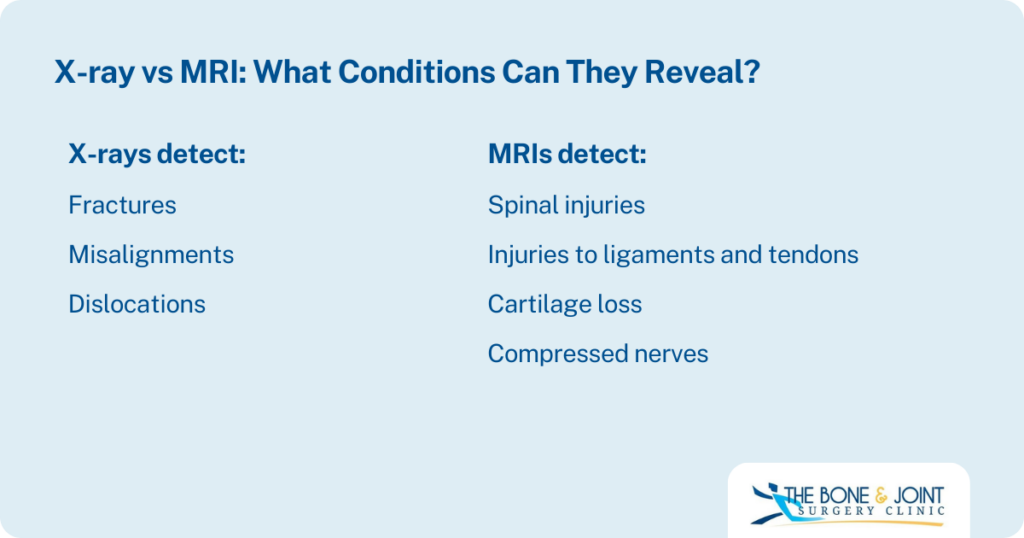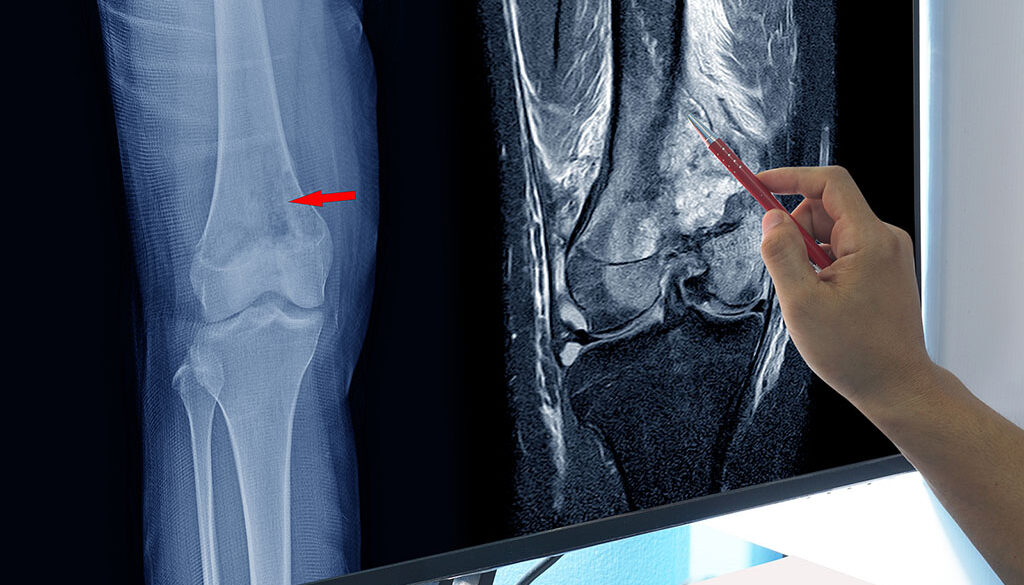MRI vs X-Ray: The 5 Key Differences and How They Help You
Whether you’ve injured your ankle or you’ve been struggling with chronic knee pain, diagnostic imaging is key to helping us uncover the source of your problem. These advanced techniques allow us to make a precise diagnosis, so we can create a personalized treatment plan tailored to your needs.
Sometimes, we may suggest an X-ray, other times, an MRI may give us a better picture of the information we need. We understand the differences between an MRI vs. X-ray can be confusing, but they each serve a very specific role in how we care for you.
We’ll explore the 5 key differences between an MRI vs. X-ray, and examine how each plays an important role in your healthcare plan.
What’s the Difference Between an X-ray and an MRI?
Before we delve into the differences, let’s briefly review what an MRI vs. an X-ray is.
How Does an MRI Work?
MRI stands for magnetic resonance imaging. MRIs do not use any radiation. Instead, they utilize a powerful magnet and radio waves. These pass through the body, react with its protons, and create detailed pictures.
How Does an X-ray Work?
This type of imaging sends radiation through your body. Bones and teeth block the radiation, creating the white areas on the image. An X-ray is typically the first type of screening we use when assessing fractures and injuries.
5 Key Differences Between an X-ray vs. MRI
1. Technology
We touched on this difference earlier. While X-rays use ionizing radiation, MRIs utilize magnets to create an image.
2. Types of Images Produced
An MRI provides detailed images of soft tissues, such as ligaments, organs and muscles. X-rays are primarily used to assess bones and more dense structures.

3. Safety
Both MRIs and X-rays are generally safe, but because an MRI uses magnets, it may not be appropriate for those who have certain implants or devices, such as a pacemaker.
While X-rays utilize a low level of radiation, it is important to avoid excessive amounts of repeated exposure.
4. Cost and Availability
X-rays are less expensive, readily available and are often used as the first type of imaging to evaluate an injury or illness.
MRIs are typically more expensive and may not be available in certain areas.
Fortunately, at the Raleigh Bone and Joint Surgery Clinic, we have Wake County’s first and only open-bore MAGNETOM Verio 3T MRI. This MRI represents the best in innovation, offering more comfort, a quicker exam and the highest level of detailed images to help us diagnose and treat you.
5. How Long It Takes
X-rays typically take only a few minutes, while an MRI can take as long as 30 minutes.
The MRI also requires the patient to remain still in a machine, and if you are claustrophobic, it can be uncomfortable. However, our open-bore MRI at the Bone and Joint Surgery Clinic has a wider opening, meaning you’re more comfortable during the entire procedure.
What Conditions Can an MRI/X-ray Reveal?
There is a wide variety of conditions that an MRI/X-ray can reveal, ranging from fractures to bone deterioration. We’ll take a look at when an MRI vs. X-ray may be warranted.
What Can an X-ray Detect?
X-rays are easily able to spot:
- Fractures
- Misalignments
- Dislocations
What Can an MRI Detect?
If we suspect more subtle bone injuries or soft tissue problems like torn tendons, an MRI may be warranted. MRIs can detect:
- Spinal injuries
- Injuries to ligaments and tendons
- Cartilage loss
- Compressed nerves
What Happens During an X-ray/MRI at The Bone and Joint Surgery Clinic?
Taking an X-ray is simple and straightforward. You’ll undress the part of your body that needs to be X-rayed. You’ll need to remove metal objects such as jewelry because they will show up on the imaging.
Having an MRI is similar. You should dress comfortably. Do not wear anything metallic. We’ve gone into detail about how to get ready for the procedure in our earlier article, “Are You Ready for Your Orthopedic MRI?”
Our Open Bore MRI: Leading Technology Ready to Serve You
We’ve already mentioned some of the benefits of our open-bore MRI, but did you realize that not only does it provide extraordinarily detailed images for your orthopedic surgeon in Raleigh, but it also provides a more relaxing experience?
It has an extra large opening, so it’s able to accommodate a variety of patients and reduces anxiety. This makes it perfect for those who may experience claustrophobia.
Dealing With Pain or An Injury? Trust Your Care to the Bone and Joint Surgery Clinic of Raleigh
Our superior imaging services enable us to diagnose your condition quickly and accurately.
We combine the best in technology with the leading board-certified orthopedic surgeons in the area. Contact us today to schedule an appointment.
The content within this article and others on this website is only for educational purposes and should not be considered as medical advice. For any questions or concerns, please consult with your healthcare provider.
====
Sources:
Johns Hopkins Medicine, “CT Scan Versus MRI Versus X-Ray: What Type of Imaging Do I Need?” https://www.hopkinsmedicine.org/health/treatment-tests-and-therapies/ct-vs-mri-vs-xray
University of California- San Francisco, “MRI,” https://radiology.ucsf.edu/patient-care/services/mri

